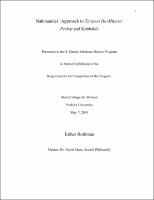Please use this identifier to cite or link to this item:
https://hdl.handle.net/20.500.12202/4504Full metadata record
| DC Field | Value | Language |
|---|---|---|
| dc.contributor.advisor | Shatz, David | en_US |
| dc.contributor.author | Rothman, Esther | |
| dc.date.accessioned | 2019-07-10T16:43:58Z | |
| dc.date.available | 2019-07-10T16:43:58Z | |
| dc.date.issued | 2019-05-07 | |
| dc.identifier.citation | Rothman, Esther. Nahmanides’ Approach to Ta‘amei Ha-Mitzvot: Peshat and Kabbalah. Presented to the S. Daniel Abraham Honors Program in Partial Fulfillment of the Requirements for Completion of the Program Stern College for Women Yeshiva University May 7, 2019. | en_US |
| dc.identifier.uri | https://hdl.handle.net/20.500.12202/4504 | |
| dc.identifier.uri | https://ezproxy.yu.edu/login?url=https://repository.yu.edu/handle/20.500.12202/4504 | |
| dc.description | The file is restricted for YU community access only. | en_US |
| dc.description.abstract | It is evident that Ramban has a nuanced presentation in the study of ta‘amei hamitzvot, one that includes multiple levels of understanding. Initially, it might appear as if Ramban presents two opposing approaches in his parshanut, the peshat/anthropocentric approach where mitzvot are meant to benefit man and the kabbalistic/theocentric approach where mitzvot are meant to benefit G-d. The many scholars presented try to explain this apparent contradiction and shed light on other topics Ramban discusses. What this paper has argued is that there is possibly a third level, one that combines anthropocentric and theocentric, that can serve as a link between the two levels. As Ramban in his commentary on Exodus 20:23, in his discussion with respect to ascending the altar writes: “Each of G-d’s commandments has many reasons, there being many benefits in each one for body and soul” (Nahmanides 1973, 337). This one sentence by Ramban fully encapsulates his overall view of ta‘amei ha-mitzvot: that there are different levels to the reason for each commandment. (from Conclusion) | en_US |
| dc.description.sponsorship | S Daniel Abraham Honors Program of Stern College for Women | en_US |
| dc.language.iso | en_US | en_US |
| dc.publisher | Stern College for Women Yeshiva University. | en_US |
| dc.rights | Attribution-NonCommercial-NoDerivs 3.0 United States | * |
| dc.rights.uri | http://creativecommons.org/licenses/by-nc-nd/3.0/us/ | * |
| dc.subject | senior honors thesis | en_US |
| dc.subject | Nahmanides | en_US |
| dc.subject | Ramban | en_US |
| dc.subject | Moses ben Nahman | en_US |
| dc.subject | Naḥmanides, approximately 1195-approximately 1270. | en_US |
| dc.subject | Ta‘amei Ha-Mitzvot | en_US |
| dc.subject | Peshat | en_US |
| dc.subject | Kabbalah | en_US |
| dc.title | Nahmanides’ Approach to Ta‘amei Ha-Mitzvot: Peshat and Kabbalah. | en_US |
| dc.type | Thesis | en_US |
| Appears in Collections: | S. Daniel Abraham Honors Student Theses | |
Files in This Item:
| File | Description | Size | Format | |
|---|---|---|---|---|
| Esther Rothman - Honors Thesis.pdf Restricted Access | The file is restricted for YU community access only. | 229.74 kB | Adobe PDF |  View/Open |
This item is licensed under a Creative Commons License

